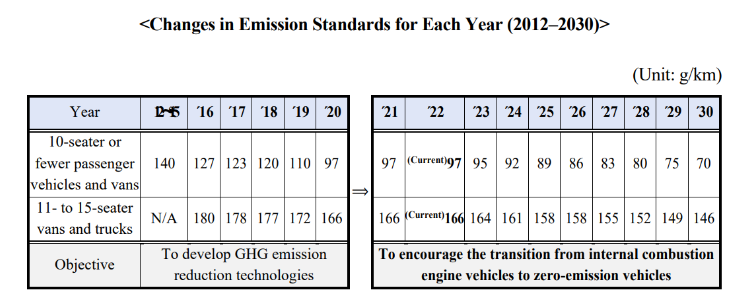Korea's Recent Environmental Laws, Reports, and Press Releases based on KEI Research
- Date2023-03-17 13:35
- TypePress Release
- View143
▷ Greenhouse gas emissions from vehicles recorded 129% of the GHG emission standard in 2020. It is expected to improve in 2021
Sejong, November 28 - The Ministry of Environment (Minister Han Wha-jin) issued reports of regulations for greenhouse gas emissions from vehicles from 2016 to 2020. The reports include nineteen vehicle manufacturers' performance and whether they meet GHG emissions standards from 2016 to 2020. The regulations for greenhouse gas emissions from vehicles aim at cutting GHG emissions from vehicles in the transportation sector. It has come into effect since 2012 under the Clean Air Conservation Act and the Framework Act on Carbon Neutrality and Green Growth for Coping with the Climate Crisis. The emission standard was initially set at 140 g/km in 2012. It has steadily strengthened and is now 97 g/km as of 2020. The average GHG emissions of 10-seater or fewer passenger vehicles and vans of the 19 vehicle manufacturers were 125.2 g/km in 2020, accounting for 129% of the year's standard of 97 g/km. The increase in sales of zero-emission vehicles, such as electric and hydrogen vehicles, is expected to lower GHG emissions between 2021 and 2022.
Vehicle manufacturers are obliged to produce and sell vehicles so that the average annual greenhouse gas emission of vehicles sold meets the greenhouse gas emission standards for the year. Manufacturers exceeding the standards may transfer or trade the excess emission allowances, whereas those that fall short of the cap must surrender the sufficient allowances within three years. The primary objective of the emission cap for the years 2012 (140 g/km) and 2020 (97 g/km) was to encourage the development of GHG reduction technologies for internal combustion engine vehicles. In addition, the emission caps for 2021 (97 g/km) and 2030 (70 g/km) were set to promote the transition from internal combustion engine vehicles to zero-emission vehicles.

The four-year analysis of vehicle manufacturers' performance shows that the "legal" GHG emissions of all 19 vehicle manufacturers decreased from 139.7 g/km in 2016 to 125.2 g/km in 2020. However, there were no improvements in their "real" emissions, which were calculated based on net sales, with 142.8 g/km in 2016 and 141.3 g/km in 2020. It is assumed to be because the distribution of zero-emission vehicles, including electric vehicles (EVs), began in earnest from 2020, and an increasing number of domestic consumers prefer full-size vehicles. However, it is projected that there will be significant reductions in GHG emissions because major domestic manufacturers released new EV models in 2021, and the number of vehicles purchased with subsidies continues to grow. Moreover, the projected sales of zero-emission vehicles would be more than doubled in 2022 compared to 2021, so greenhouse gas emissions would be decreased.Out of 19 vehicle manufacturers, more manufacturers each year failed to meet the emission cap, from 5 in 2016 to 13 in 2020. Most of them have offset by transferring the excess emission allowances they accumulated in the past. Only the shortages of Renault Korea Motors, SsangYong Motor, and FCA Korea from 2019 to 2020 and the shortage of Kia Motor in 2020 have yet to be made up for, and they are required to return the amounts within three years.
The Ministry of Environment plans to streamline the process from submission to ation and disclosure of each manufacturer's average emissions performance and prepare the return-and-trade system promptly. It will enable manufacturers to devise rapidly and methodically sales plans for each type of vehicle for observing the emission cap. To this end, the ministry will pursue the revision of the "Public Notice of Average Energy Efficiency Standard for Automobiles & Greenhouse Gas Emissions Cap and the Application and Management of the Standards" as soon as possible.
"Each vehicle manufacturer must release various models of zero-emission vehicles and put more effort into increasing the percentage of their sales to attain carbon neutrality by 2050," said Park Yeon-jae, Director-General of the Air Quality Policy Bureau.
[Source: Press Release (me.go.kr)]
